The Constitution was written more than two centuries ago when slavery was the law of the land in half of the United States and women had few legal rights. In the first 160 years of the Court’s existence, the justices tended to reflect these biases, largely ruling to defend the interests of businesses and the wealthy elite rather than the general public.
But in the 1950s and 1960s, a change came. Many Americans rallied for protections for the civil rights and liberties of all people, regardless of race, gender, or sexuality. Congress passed legislation and constitutional amendments to enshrine evolving notions of equality into law. And the Supreme Court helped drive fundamental social change across the nation for a half century.
Its rulings during this period led to significant advances for civil rights, women’s rights, and gay rights, as well as the rights of criminal defendants, protesters, and the press. Yet more recent years have seen the Court backslide in many areas, with reduced protections for reproductive freedom, voting rights, and fair representation.
The following decisions show how the high court has wrestled with some of history’s biggest social, legal, and political issues.







